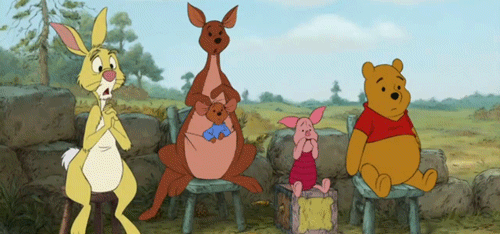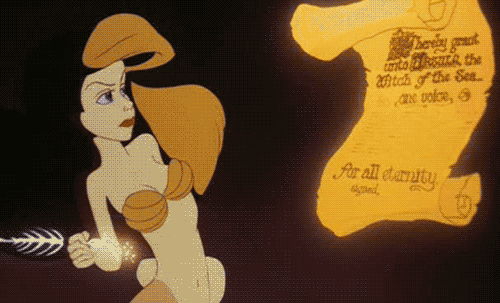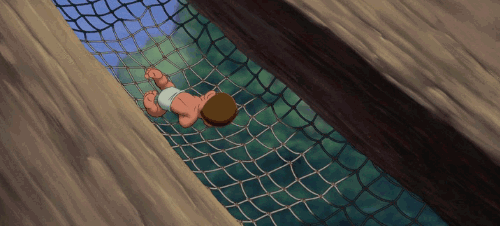A GIF is an image that can support animation. Nothing too complicated, mind you, just a few actions. Roughly as much as we’d see, passing by an animatronic in a dark ride.
Here, for example, is a GIF of the clock from it’s a small world.

Just wait 'til the hour strikes.
Any minute, now.
...aaaaaany minute, now.
That’s all that clock does, all day, every day, rain or shine. There are classier ways to argue for theme parks as a valid artistic medium, but goddamn if that 8-bit image doesn’t capture what makes that clock as fun as it is in real life.
Some animatronics take their GIF-like movement a step further--by telling stories. There are fewer of these characters, but they enrich their surroundings immeasurably.
A ride populated with living characters who tell small-but-complete stories feels less like a narrative and more like a world. Everyone’s dealing with their own problems, but they’re all related to problems you’d find in the jungle. Or with ghosts, or pirates, et cetera.
Let's discuss the GIF story and some of the components that help it work.
But first, a disclaimer:
Of course, there aren’t many GIFs of animatronics. That would be helpful. That would illustrate my theory. That would make this essay easier to read. Thank heavens the internet hasn’t cursed us with more than a handful of GIFs of animatronics.
The internet has, mercifully enough, provided us with a wealth of GIFs from Disney cartoons. In theory, these could be adapted into animatronic figures, so for our purposes, we’ll pretend that’s what they are.
Consider the following GIF.

Here, some of our friends from the Hundred Acre Woods listen as Christopher Robin speaks.
The action implies a story.
With GIFs, we have to understand the story immediately, and it has to be clear, since we’re not in the ride for very long. We don’t have enough time to appreciate nuances.
In the GIF from Winnie the Pooh, our protagonists--Rabbit, Kanga, Roo, Piglet, and Pooh--share the objective of listening to Christopher Robin’s speech. The tension is, “Will our protagonists get distracted?” Humorously, the answer is, “No.” They’re so fixated that nothing--not even their antagonist, an intrusive jack-in-the-box--will stop them.
The story begins with Piglet springing up, continues with Pooh pushing him back down, and ends with Piglet springing back up again. That is, it could end with Piglet springing back up, and just dealing with it, but it doesn’t.
The action repeats.
Clearly, Christopher Robin is delivering a captivating speech. Nothing will stop these characters from hearing the end of it. Not even if it means pausing to replace the jack-in-the-box with a proper chair. The speech is that good.
GIF stories repeat for a practical purpose. Should we get stuck in the ride, and forced to watch this story for minutes rather than seconds, it may get boring, but it’ll still make sense. Even if we’re stuck there for decades...boy, what a speech!
The action repeats for a reason.

Here, the action does, indeed, imply a story. Our protagonist, Ariel, realizes her objective to become human by ignoring her antagonist, Sebastian, who’s offscreen, begging her not to sign the contract.
That’s all well and good, but this wouldn’t make a satisfying animatronic. How many times can she sign the damn thing? Besides the puberty-forging angle at which she arches her back, there’s no reason for this action to repeat. Watch it any longer than the length of one signature, and the fourth wall is broken.
The repeating action is seamless.

Here, our protagonist, Tarzan, achieves his objective of escaping from his antagonist, Sabor the jungle cat. The action repeats for a reason: Tarzan is having a great time, and he could do this forever--or at least until he’s old enough to understand that jesus christ he’s being hunted by a jungle cat save me save me why won’t anyone save me.
This GIF would make an effective scene in a dark ride. Unfortunately, it would require a cast member to schlep the animatronic baby from the bottom of the net back up to the top of it, which is costly and distracting.
This principle is so obvious that explaining it verges on cynicism. Nevertheless, it bears spelling out: we notice unmotivated repetitions, even if we don’t get stuck on the ride.
Consider this video of Ursula, from the Little Mermaid ride that's in the Magic Kingdom and California Adventure.
If you remember the movie, Ursula sings “Poor Unfortunate Souls” to dupe Ariel into a Faustian covenant.
Meanwhile, in the ride, she sings random verses of “Poor Unfortunate Souls” to an omnimover full of random people, breaks into Latin upon whim, and ignores the movie she’s playing on her crystal ball. That’s her action--a bundle of seams--and she repeats it forever.
Why would she do that? Is she going senile, and attempting to make a comeback with her twenty-year-old single? Her action doesn’t even make sense the first time, and the more she repeats it, the thicker the fourth wall gets.
The action is an action.
That is, if it’s a GIF story. There are stories that involve inert characters--and even stories that involve no characters whatsoever. But a GIF story requires an action.
Here, Lady Tremaine wants to intimidate Cinderella, but Cinderella’s being uncharacteristically courageous. Her action--stroking Lucifer--could either be repeating because Tremaine wants to make Cinderella sweat it out, or because she’s biding her time while Cinderella finishes talking.
In order to understand how important movement is, let’s compare the GIF with a frame from the same shot.
Notice that the story still works. Heck, Tremaine might be more intimidating, without moving--but not for long. The tension doesn’t last. After a few seconds, we begin to wonder if she’s catatonic, or maybe taxidermied.
Movement provides an illusion of life. It helps us believe that Tremaine is real, and so motivated that she’ll gladly glare until she dies and gets taxidermied back into this position.



I always found this to be the major problem with omnimover, as specific ride events just can't exist (e.g. no boulder threatens to run down your car). I kinda lumped all omnimovers together in one category where perpetual motion is necessary for structural integrity. Of course, after getting stuck on both Little Mermaid and Haunted Mansion, *boy* I could see the difference.
ReplyDeleteTotally. I'm sure it's hard to come up with a reason why every single character in a dark ride is endlessly repeating an action, but boy, does that pay off.
Delete